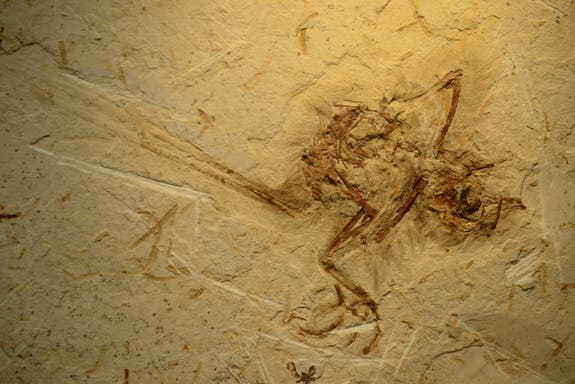Paleontologists have discovered the wonderfully preserved fossil of a prehistoric bird which flew through the forests of the ancient supercontinent Gondwana, some 115 million years ago. The humming bird-sized bird had a spotted, ribbon shaped tail. The remains were discovered in a sedimentary hotspot in nowadays Brazil. It’s the first of its kind discovered in South America and one of the oldest birds discovered from Gondwana, a supercontinent that once encompassed Africa, Antarctica, Australia, India and South America.

When Ismar de Souza Carvalho, a professor of paleontology and geology at the Federal University of Rio de Janeiro, first came across the fossil we couldn’t help but utter: “What’s this?” Upon careful inspection, he realized he had come across a gem as far as paleontological findings go. Trapped inside a sedimentary bed in Brazil’s Araripe Basin, where previously scientists discovered thousands of fossilized insects, flying reptiles, turtles, fish, the fossilized remains of the ancient birds tell a unique story of a long lost ecosystem.

It’s a rare find, indeed, but even more remarkable is its anatomy. Thanks to its pristine condition, the fossil shows what the bird looked like. It was likely a juvenile, judging from its large eyes relative to its body, which is only 2.4-inch-long. The tail, however, took everyone by surprise. Measuring 3.1 inches (8 cm) – a lot larger than the body itself – the tail is shaped like a ribbon, resembling two arrows taped to its behind. Considering the tail isn’t very aerodynamic at all, Carvalho and colleagues suggest it served some other purpose, either as a means to distinguish among themselves or as a decoration for mating.

The specimen has yet to be included as a new species, as researchers need more time to compare its features with other birds from the same period. What they know for certain so far is that it belonged to a diverse group of dinosaur-age birds called Enantiornithes. This group was not discovered until 1981, at which time some very unusual, isolated bones from the Late Cretaceous of Argentina were recognized as belonging to a new group of birds. Enantiornithine birds are now known to be widely distributed, with remains from Argentina, North America, Mexico, Mongolia, Australia, Spain, and China. Paleontologists take a special interest in enantiornithes since the species include both specialized and primitive features, suggesting they represent an evolutionary side branch of early avian evolution. Souza Carvalho describes the importance of the findings below:
What’s more, the findings prove that enantiornithes also lived in Gondwana, not just Laurasia as previously suggested.


